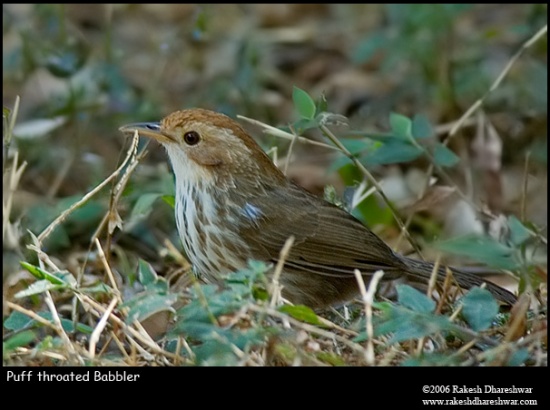Alternative Names: Spotted Babbler; Striped Babbler
- Pellorneum ruficeps
Identification
15 - 17cm (6-6¾ in). A smallish babbler:
- Plain brown above
- Rufous or chestnut crown
- Broad pale supercilium
- White below with bold dark streaks on breast and flanks
- Large headed with fairly long narrow tail
Males are larger than females and have heavier streaks on breast.
Variations
The various subspecies differ slightly in colouration and in intensity of the dark streaks.
Distribution
Found from north Pakistan east in the Himalayas over India, Nepal and Bhutan to Burma, Bangladesh, south China (Yunnan), Thailand, Laos, Vietnam, Cambodia and northern peninsular Malaysia. Also in the hills and mountains of central, south and east India.
Generally common in its range.
Taxonomy
Subspecies
28 subspecies are already described and more may exist. Some of these subspecies have tiny ranges.
Pellorneum ruficeps is the type species of its genus. There are some hints that Pellorneum may consist of several lineages (Jønsson & Fjeldså 2006). If the genus would be split into two or more, the Puff-throated Babbler and its closest relatives would remain in Pellorneum.
- P. r. olivaceum: South West India (Kerala)
- P. r. ruficeps: peninsular India (except southwest in Kerala, and in northeastern Ghats)
- P. r. pallidum: eastern India (northeastern Ghats)
- P. r. punctatum: West Himalayas (Kangra to Garhwal)
- P. r. mandellii: Nepal to Sikkim, Bhutan and north-eastern India (Darjiling District)
- P. r. chamelum: South Assam south of the Brahmaputra (Garo Hills to Naga Hills)
- P. r. pectorale: North East Assam (Mishmi Hills)
- P. r. ripleyi: North East Assam south of the Brahmaputra (Lakhimpur District)
- P. r. vocale: North East India (valley of central Manipur)
- P. r. victoriae: North Myanmar (Chin Hills)
- P. r. stageri: North East Myanmar (Myitkyina and Bhamo districts)
- P. r. shanense: Central Myanmar (North and South Shan States) to southern China (south-western Yunnan)
- P. r. hilarum: Arid zone of central Myanmar
- P. r. minus: South Myanmar (lower Irrawaddy River)
- P. r. subochraceum: South Myanmar and adjacent south-western Thailand
- P. r. insularum: South Myanmar (Mergui Archipelago)
- P. r. acrum: Central plains of Thailand and north Malay Peninsula
- P. r. chthonium: North plateau of Thailand
- P. r. indistinctum: Mekong River drainage of northern plateau of Thailand
- P. r. oreum: South China (southern Yunnan between Mekong and Salween river)
- P. r. vividum: South Yunnan (Red River Valley) to extreme northern Tonkin and central Annam
- P. r. elbeli: North-west part of eastern plateau of Thailand
- P. r. dusiti: west slope of Dong Phraya Fai Range (western part of northeastern Thailand)
- P. r. ubonense: East part of eastern plateau of Thailand and adjacent southern Laos
- P. r. deignani: South Vietnam
- P. r. dilloni: South Indochina
- P. r. euroum: Central plains of Thailand (east of Chao Phaya) to western Cambodia
- P. r. smithi: Islets off coastal south-eastern Thailand and Cambodia
Habitat
Found in floor and understorey of deciduous or broadleaf evergreen forest, teak forest, secondary growth and bamboo. Also tea gardens, scrub, sholas, forest edge and thickets in ravines. Up to 1900m.
Behaviour
Diet
Feeds on insects.
Usually seen in pairs or small groups. Forages on the ground, turning over leaves.
Breeding
Breeding season from March to August. Multi-brooded. The nest is a large ball or dome or cup made of dead bamboo, other leaves, moss, grasses, plant fibres and dead twigs. It's placed on the ground. Lays 2 - 5 eggs.
Movements
Resident species.
References
- Clements, J. F., T. S. Schulenberg, M. J. Iliff, S. M. Billerman, T. A. Fredericks, J. A. Gerbracht, D. Lepage, B. L. Sullivan, and C. L. Wood. 2021. The eBird/Clements checklist of Birds of the World: v2021. Downloaded from https://www.birds.cornell.edu/clementschecklist/download/
- Del Hoyo, J, A Elliott, and D Christie, eds. 2007. Handbook of the Birds of the World. Volume 12: Picathartes to Tits and Chickadees. Barcelona: Lynx Edicions. ISBN 978-8496553422
- Rasmussen, PC and JC Anderton. 2005. Birds of South Asia: The Ripley Guide. Barcelona: Lynx Edicions. ISBN 978-8487334672
Recommended Citation
- BirdForum Opus contributors. (2025) Puff-throated Babbler. In: BirdForum, the forum for wild birds and birding. Retrieved 9 May 2025 from https://www.birdforum.net/opus/Puff-throated_Babbler
External Links
GSearch checked for 2020 platform.1






